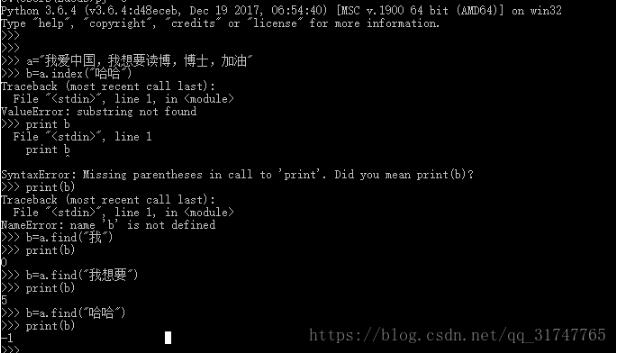Python中是有查找功能的,五种方式:in、not in、count、index,find 前两种方法是保留字,后两种方式是列表的方法。
下面以a_list = ['a','b','c','hello'],为例作介绍:

string类型的话可用find方法去查找字符串位置:
a_list.find('a')
如果找到则返回第一个匹配的位置,如果没找到则返回-1,而如果通过index方法去查找的话,没找到的话会报错。

补充知识:Python中查找包含它的列表元素的索引,index报错!!!
对于列表["foo", "bar", "baz"]和列表中的项目"bar",如何在Python中获取其索引(1)?
一、index
>>> ["foo", "bar", "baz"].index("bar")
警告如下
请注意,虽然这也许是回答这个问题最彻底的方法是问,index是一个相当薄弱的组件listAPI,而我不记得我最后一次使用它的愤怒。在评论中已经向我指出,因为这个答案被大量引用,所以应该更加完整。关于list.index跟随的一些警告。最初可能需要查看文档字符串:
>>> print(list.index.__doc__) L.index(value, [start, [stop]]) -> integer -- return first index of value. Raises ValueError if the value is not present.
我曾经使用过的大多数地方index,我现在使用列表推导或生成器表达式,因为它们更具有推广性。因此,如果您正在考虑使用index,请查看这些出色的python功能。
如果元素不在列表中,则抛出
如果项目不存在则调用index结果ValueError。
>>> [1, 1].index(2) Traceback (most recent call last): File "<stdin>", line 1, in <module> ValueError: 2 is not in list
如果该项目可能不在列表中,您应该
首先检查它item in my_list(干净,可读的方法),或
将index呼叫包裹在try/except捕获的块中ValueError(可能更快,至少当搜索列表很长时,该项通常存在。)
大多数答案解释了如何查找单个索引,但如果项目在列表中多次,则它们的方法不会返回多个索引。用途enumerate():
for i, j in enumerate(['foo', 'bar', 'baz']):
if j == 'bar':
print(i)
该index()函数仅返回第一个匹配项,同时enumerate()返回所有匹配项。
作为列表理解:
[i for i, j in enumerate(['foo', 'bar', 'baz']) if j == 'bar']
这里还有另一个小解决方案itertools.count()(与枚举几乎相同):
from itertools import izip as zip, count # izip for maximum efficiency
[i for i, j in zip(count(), ['foo', 'bar', 'baz']) if j == 'bar']
对于较大的列表,这比使用更有效enumerate():
$ python -m timeit -s "from itertools import izip as zip, count" "[i for i, j in zip(count(), ['foo', 'bar', 'baz']*500) if j == 'bar']" 10000 loops, best of 3: 174 usec per loop $ python -m timeit "[i for i, j in enumerate(['foo', 'bar', 'baz']*500) if j == 'bar']" 10000 loops, best of 3: 196 usec per loop
三、NumPy
如果您想要所有索引,那么您可以使用NumPy:
import numpy as np array = [1, 2, 1, 3, 4, 5, 1] item = 1 np_array = np.array(array) item_index = np.where(np_array==item) print item_index # Out: (array([0, 2, 6], dtype=int64),)
它是清晰易读的解决方案。
四、zip
具有该zip功能的所有索引:
get_indexes = lambda x, xs: [i for (y, i) in zip(xs, range(len(xs))) if x == y]
print get_indexes(2, [1, 2, 3, 4, 5, 6, 3, 2, 3, 2])
print get_indexes('f', 'xsfhhttytffsafweef')
以上这篇对python中list的五种查找方法说明就是小编分享给大家的全部内容了,希望能给大家一个参考,也希望大家多多支持自学编程网。

- 本文固定链接: https://zxbcw.cn/post/190625/
- 转载请注明:必须在正文中标注并保留原文链接
- QQ群: PHP高手阵营官方总群(344148542)
- QQ群: Yii2.0开发(304864863)
